I came across a piece by Stratford Caldecott just now - this is an extract...
Perhaps what is missing in much religious formation is the vital instruction to look for God within ourselves. That is to be distinguished from identifying ourselves with God, or thinking that God is Myself. As G.K. Chesterton said, “Of all horrible religions the most horrible is the worship of the god within. Any one who knows any body knows how it would work; any one who knows any one from the Higher Thought Centre knows how it does work. That Jones shall worship the god within him turns out ultimately to mean that Jones shall worship Jones. Let Jones worship the sun or moon, anything rather than the Inner Light; let Jones worship cats or crocodiles, if he can find any in his street, but not the god within.”
No, what I mean is that we need to discover God at the root of ourselves if we are discover him anywhere at all. Within ourselves, but beyond the self, is the living presence of the God who creates all things from the inside out. That is the God who is closest to us, whose reality is most evident. When we are tormented by the problem of evil, or uncertain about the meaning or value of Scripture, there are voices in our head that say, “You know it doesn’t really make any sense!” But there is a much quieter voice we need to learn to hear that whispers, “Just be patient and trust, and I will lead you to what you need to know.” That quieter voice is harder to hear because it comes from a deeper level - not from the self but from beyond the self.Read the full article in Second Spring
torsdag 26 februari 2009
"Bishop" Bonkers the holocaust denier
The Pope has come under criticism for lifting the excommunication of "Bishop" Williamson of the Society of St Pius X. However the "Bishop" was excommunicated for being a member of a sect which by its actions denied the authority and discipline of the Catholic church. "Bishop" needs to be in quotes because the person who appointed him had no authority to do so and he had no authority to deny it.
The excommunicated sect to which he belongs was established to maintain the so-called Tridentine Mass at a time when the liturgy was being dumbed down by priests acting on their own initiative, aided and abetted by many bishops. and have prayers in badly translated and crass English instead, with jolly folk tunes instead of the traditional ones with Gregorian Chant and music by composers such as Palestrina. Rather like Orthodox Jews suddenly being told to stop using Hebrew. A significant minority of Catholics then started to attend these traditional services, which they should have known better than to do, but when the local official alternative was offering guitars and handclapping, one can understand why they voted with their feet.
The present Pope, plus those responsible for such matters, have finally got a grip on the situation. As part of this, there is now a move to bring back these renegade congregations, as well, incidentally, as members of the Anglican church who are unhappy at the way it is moving. Hence the lifting of the excommunication on members of the sect, which does not automatically make its "priests" and "bishops" into priests and bishops in good standing in the Catholic church; each one would have to be investigated and probably re-ordained if suitable. Which Bonkers clearly is not.
Since the holocaust is not an article of faith it, denying it is not grounds for excommuncation, though if the idiot spouted his nonsense in my own parish he would be screamed at and hopefully given a hard kicking by someone who was actually in Auschwitz and witnessed the holocaust with her own eyes as a 14 year old girl.
The best thing this vile creature could do now would be to take a vow of silence and lock himself up in a monk's cell for the rest of his days.
As regards anti-semitism in the Catholic church - it is true to say that there has been a strand of it in varying measure from the middle ages up to the 1950s but it is extremely rare to come across it these days. The rescue and protection of Jews by Catholic clergy, including the Pope himself, and by religious communities WW2, is well documented, including the action by the Dutch bishops which resulted in Jews who were Catholics being sent to the death camps. There is the well known case of the Catholic nun Edith Stein who allowed herself to die as a Jew in Auschwitz when she could easily have been hidden away in her convent. In eastern Europe, the help was less forthcoming because of ingrained anti-semitism whose cause was partly due to church influence but also of economic origin.
But don't forget to pray for Richard Williamson.
The excommunicated sect to which he belongs was established to maintain the so-called Tridentine Mass at a time when the liturgy was being dumbed down by priests acting on their own initiative, aided and abetted by many bishops. and have prayers in badly translated and crass English instead, with jolly folk tunes instead of the traditional ones with Gregorian Chant and music by composers such as Palestrina. Rather like Orthodox Jews suddenly being told to stop using Hebrew. A significant minority of Catholics then started to attend these traditional services, which they should have known better than to do, but when the local official alternative was offering guitars and handclapping, one can understand why they voted with their feet.
The present Pope, plus those responsible for such matters, have finally got a grip on the situation. As part of this, there is now a move to bring back these renegade congregations, as well, incidentally, as members of the Anglican church who are unhappy at the way it is moving. Hence the lifting of the excommunication on members of the sect, which does not automatically make its "priests" and "bishops" into priests and bishops in good standing in the Catholic church; each one would have to be investigated and probably re-ordained if suitable. Which Bonkers clearly is not.
Since the holocaust is not an article of faith it, denying it is not grounds for excommuncation, though if the idiot spouted his nonsense in my own parish he would be screamed at and hopefully given a hard kicking by someone who was actually in Auschwitz and witnessed the holocaust with her own eyes as a 14 year old girl.
The best thing this vile creature could do now would be to take a vow of silence and lock himself up in a monk's cell for the rest of his days.
As regards anti-semitism in the Catholic church - it is true to say that there has been a strand of it in varying measure from the middle ages up to the 1950s but it is extremely rare to come across it these days. The rescue and protection of Jews by Catholic clergy, including the Pope himself, and by religious communities WW2, is well documented, including the action by the Dutch bishops which resulted in Jews who were Catholics being sent to the death camps. There is the well known case of the Catholic nun Edith Stein who allowed herself to die as a Jew in Auschwitz when she could easily have been hidden away in her convent. In eastern Europe, the help was less forthcoming because of ingrained anti-semitism whose cause was partly due to church influence but also of economic origin.
But don't forget to pray for Richard Williamson.
måndag 16 februari 2009
Be still and know that I am God
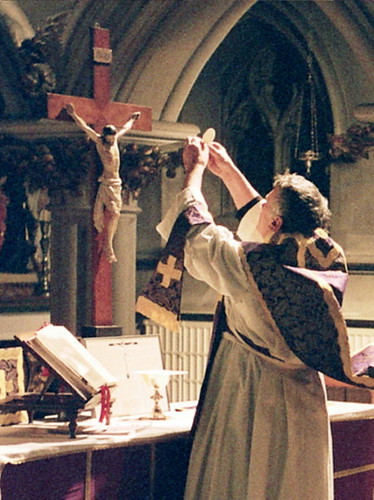
So go the words of a popular hymn, based on Psalm 46. However, stillness in the modern Catholic liturgy is more notable for its absence.
I have attended a variety of liturgies at different places in the past few months. At my local church we usually have a Novus Ordo mass with Latin chant. This is a dignified celebration and as good as it gets when most of the prayers are in English, which is always mildly irritating due to the bad translation and the kitschy "and also with you" response.
At the end of last year I was in Marlow one Sunday and went to mass there, in a nasty 1980s church with a bare brick interior, with unpleasant modern hymns which I had never heard before, sung by a small choir because nobody else present seemed to know them either. Then, in mid-January, I was in Salisbury, which the liturgy used to be quite reasonable but has been distinctly odd recently. On my previous trip, the music was 1970s, and the priest delivered his sermon whilst walking up and down the aisle, which was disconcerting. So I decided to give it a miss and went to an Extraordinary Form mass at Warminster, which involved a 45 minute bus ride each way on a cold evening. But it was worth it not to end up being annoyed.
In my own parish we had an Extraordinary Form sung mass on the Feast of the Presentation, and another, a Requiem for the Parish Priest's father, a few days later. There was plenty of silence at these.
On the Sunday we were promised a "children's mass". From past experience, these consist of jolly hymns with simple tunes, and a clapping Gloria, accompanied by recorded music played too loud on a bad public address system. Numinous it isn't. The readings are done by children, many of whom sound as if they don't know the meaning of the words they are saying - they are just mouthing the letters on the page. I end up feeling angry and avoid them these days, so I went with a friend to another parish.
My heart sank when I saw the list of hymns - banal 1970s tunes, accompanied by violinists and wind players, plus a guitar. It was a pity about the music because the strings and wind instruments actually produced a good sound, but the guitar, as usual was a disaster with a horrible and insistent chunger-chunger-chunger-chunger background.
Then off to Sweden, where the music tends to be old Swedish settings of Gregorian chant, and since the translation is reasonably true to the Latin, the liturgy is satisfactory in a functional sort of way and is never an obstacle to worship. So the next three weeks will be fine and presumably there will be no more children's liturgies for a while.
Following Vatican II, the official view on the language and music in the liturgy is as follows
This music is well within the abilities of the average nine-year-old child and one must ask why Catholic schools are not teaching it to their pupils so that they can participate in the singing at their Sunday parish masses. Why children need special children's masses is a question that needs to be asked. Making the liturgy childish means that religion becomes something to grow up out of. It could be one reason why young people stop going to church when they reach their teens.
The new English translation is coming soon and will be a faithful translation of the Latin. I wonder how it will go down. My first impression is that it sounds like seventeenth century English and will feel contrived. Some people might be put off by this. In any case, there is a problem with English - the moment someone opens their mouth, they are pigeonholed as regards their class and intelligence. This is a spin-off from the economic and social divisions which cut through British society. People are still judged by the way they sound their vowels! For this reason alone, it would probably be a good thing to phase out the vernacular from general use in the liturgy in English-speaking countries.
This blog has some interesting things to say on the subject.
lördag 14 februari 2009
New inter city train order
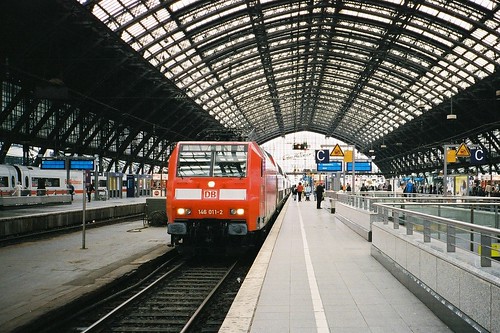
The picture above shows what the new fleet of trains for Britain's inter city routes should have looked like, not what has actually been ordered. The contract for the new fleet of inter city trains has now been awarded to Hitachi. 1400 new carriages will be purchased at a cost of £7.5 billion, which works out at £5 million per vehicle. The best thing that can be said about this is that the government has not given in to the "British jobs" argument.
But given the present mix of electrified and non-electrified lines, and no firm plans for electrification, this is not the right train for the job just now.
The electric fleet on the East Coast Main Line was introduced in 1992 and there is no urgency about replacing it. The refurbished HSTs are also good for another 15 years. The first priority should have been to get on with electrification to Bristol and Cardiff, and probably Aberdeen. Electrification to Exeter would also be desirable, but there are three possible routes to choose from - via Bristol, or Westbury or Salisbury, and of these, the latter could make more sense.
The short-distance routes are very much in the nature of commuter lines and a run-on order of something like the trains running on the Portsmouth and Bournemouth lines would have done perfectly well when the electrification was done. For routes which are unlikely ever to be electrified - beyond Exeter, for example - ordinary locomotive-hauled stock should have been ordered, with a change of traction where the electrification came to an end. The use of locomotives with hauled stock would have given a useful measure of flexibility to deal with changing circumstances, as well as enabling the continuing use of the mark 3 fleet which can apparently be kept in service indefinitely. Unfortunately, whilst flexibility is appreciated by those in the front line of railway operation, its benefits are not acknowledged by those who make the planning decisions.
Value for money?
At a cost of more than £5 million per vehicle, this order does not look like good value for money. Vehicles such as the Turbostar are presently about £1.2 million, and the price of a hauled vehicle should be of the same order. Standard European electric locomotives such as the TRAXX (photograph above) are available, at present costing about £3 million and could presumably have been adapted for British use. At a time when Britain's railways are suffering from a desperate shortage of capacity, surely it would have been better to spend the £7.5 billion on as many vehicles as could be bought for the money?
tisdag 3 februari 2009
Thoughts on train design - 3
This piece will discuss some general aspects of passenger vehicle design. There are several interacting parameters which need to be considered together.
The first of these is what is known as the static loading gauge. This can be thought of as the aperture through which all railway vehicles must be able to pass when running slowly on straight track. In practice, tracks are curved and railway vehicles cut across and project beyond the chord of a circle. Within the wheelbase, the distance cut across the curve is sometimes known as the overthrow and the projection beyond the wheelbase is referred to as the kick-out. A long vehicle cuts off more of a chord than a short one (diagram below) Taking curvature into consideration in this way leads to the concept of the dynamic loading gauge, which, however, also takes account of the suspension characteristics of the vehicle.
The diagram shows how gaps between the platform and the train will arise differently at concave and convex platform faces, and that these gaps can be minimised by keeping doorways as close as possible to bogie centres.

Following the nationalisation of Britain's railways in 1948, a survey of the infrastructure was made and an optimum loading gauge established for passenger vehicles. This was known as the C1 loading gauge and eventually it became possible for vehicles built to this gauge to operate over almost the entire system. The C1 loading gauge applied to vehicles of a nominal 20 metre width with bogies at 14.174 metre centres, of which the first were the Mark 1 fleet.
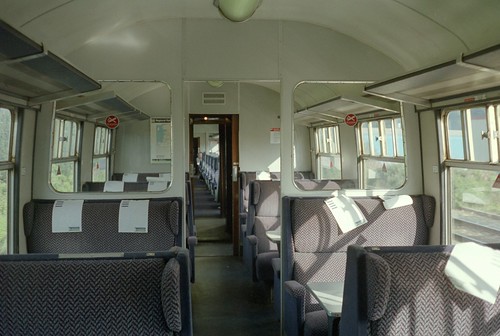
These (above) were characterised by curved bodysides with the width reducing to cantrail level (where the roof joins the bodyside)
Vehicles to a similar length are still being built, but all of them have two pairs of bi-parting doors at the 1:3/2:3 position. (below)

This divides the vehicle into three saloons, one of four bays in the middle and two of two bays at each end. This is not a particularly satisfactory arrangement. If the vehicle is a monocoque construction, then the large door apertures break into the structure at the worst possible place from the point of view of integrity. Substantial reinforcement is then required around these openings. The second drawback is that the division into three saloons imposes limitations on the alternative seat layouts that can be fitted, because the small end compartments can only be used for four rows of seats (or three and a driver's cab) or some special purposes such as a wheelchair and toilet area. The third drawback is that having just two sets of doors per vehicle leads to passengers bunching round doors at stations, which extends station dwell times. The fourth drawback is that it would be inconvenient to fit internal vestibule doors, so that passengers sitting inside are exposed to cold air in the winter when the doors are open, and there is a heavy load on the heating and ventilation system during hot and cold weather.
What are the alternatives? 20 metre long vehicles are used for two types of service. One is for long distance commuting, for example, South Coast inter city. For such routes, an end-door configuration would be more suitable, provided that attention was paid to the detailed design of the doorway (see previous article), and sufficient vestibule and circulation space was provided to prevent station dwell time from being unduly extended.

The diagram shows a ten bay vehicle, of which the two end bays are vestibules with wide doorways. It would have internal doors between vestibule and saloon, with the aim of improving passenger comfort and reducing the work required of the heating and ventilation system. Such a configuration would not be suitable for rush hour congestion and an alternative with four single doors would be. Having four doors instead of the standard 1:3/2:3 double-door configuration ought to reduce station dwell time. This is shown below. Each vestibule would occupy a full bay and be provided with space for luggage and perch-type seating. Such a train would be suitable for the inner sections of Thameslink and probably Crossrail also.
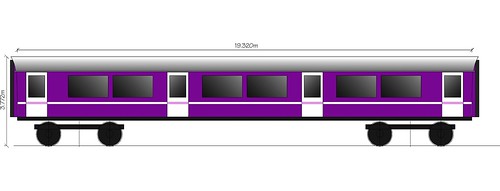
If higher traffic densities are to be handled, then trains need to have either three or more sets of double doors or two sets of double doors and single doorways at each end, the standard on tube LUL stock.
Inter city vehicles
Finally, there is the matter of longer inter city vehicles. Due to overthrow, the width of a vehicle longer than 20 metres must be reduced by an amount proportional to the square of the distance between bogie centres. This is based on the formula x squared equals h*(d-h), where x is half the length of a chord and d is the diameter. h is the distance cut off by the chord. (diagram below)
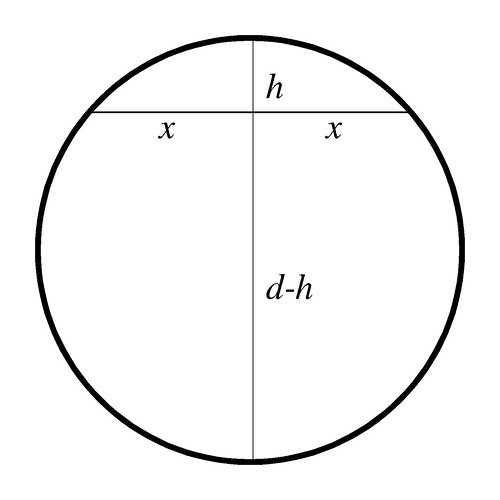
A vehicle 20 metres long can be built to the full permitted width of 2.82 metres. Based on a track curvature of 160 metres, a 23 metre vehicle must be 8 cm narrower (2.74), which is the same width as a mark 1 vehicle due to the projection of door handles etc. A vehicle 21.3 metres, however, loses just 3 cm from the width, whilst gaining an extra bay compared with a mark 1 coach.
This appears to provide an optimum length, with 9 x bays of 1.9 metres, two vestibules and a reasonable toilet. Such a vehicle is shown below. The upper illustration depicts a historic livery, perhaps because such vehicles might be used for charter work. For the same reason it is shown with sliding ventilators to avoid the need for a power supply for air conditioning, though the photograph as at the bottom give a better idea of what is envisaged. Also of note in this diagram are the toilet compartments in the centre of the vehicle. The main purpose is to simplify plumbing to the sewage retention tank, but it also divides the vehicle into two convenient sized compartments of four and five bays. The end vestibules are slightly larger than customary, with wide doors.
The same dimensions would of course apply to a vehicle fitted with sealed windows and air conditioning and internally would then closely resemble the Alstom Adelante (lower picture). Similar vehicles might well be an appropriate choice for locomotive hauled or electric multiple unit inter-city trains, such as we are likely to see if the IEP project is abandoned.


The choice of 1.9 metres for the bay dimension provides a good compromise between comfort and capacity; the vehicle shown could be fitted with 72 seats all correctly aligned to windows, with luggage space between seat backs. A first class version would have 54 seats in a 2+1 configuration on either side of the gangway. 1.9 metres is the bay dimension of the Adelante (below), which gives a good idea of the level of comfort that could be provided in such a vehicle. Were this envisaged, stainless steel bodyshells (bottom picture) would be worth considering on account of their extreme long life and low maintenance requirements.

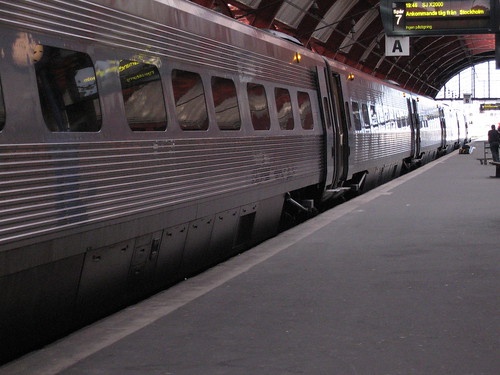
Wheelchair access
Wheelchair access toilets have to date not been particularly well integrated into the vehicle interior layout. One issue is that the size of the module does not fit with a centre aisle seating layout. Another is that there is a need to provide access to toilets from the entrance vestibule rather than from the passenger saloon to prevent annoyance from bad odours. With this in mind, it is worth considering if wheelchair access toilets should not be associated with other facilities which require an off-centre gangway, such as catering areas, first class compartments and luggage/cycle areas. It would also be worth considering whether toilets should be provided in every vehicle. It might be advantageous to concentrate toilet facilities in fewer vehicles, to avoid the need for plumbing in every coach; this may create the opportunity to offer additional facilities such as showers for passengers' use.
The first of these is what is known as the static loading gauge. This can be thought of as the aperture through which all railway vehicles must be able to pass when running slowly on straight track. In practice, tracks are curved and railway vehicles cut across and project beyond the chord of a circle. Within the wheelbase, the distance cut across the curve is sometimes known as the overthrow and the projection beyond the wheelbase is referred to as the kick-out. A long vehicle cuts off more of a chord than a short one (diagram below) Taking curvature into consideration in this way leads to the concept of the dynamic loading gauge, which, however, also takes account of the suspension characteristics of the vehicle.
The diagram shows how gaps between the platform and the train will arise differently at concave and convex platform faces, and that these gaps can be minimised by keeping doorways as close as possible to bogie centres.

Following the nationalisation of Britain's railways in 1948, a survey of the infrastructure was made and an optimum loading gauge established for passenger vehicles. This was known as the C1 loading gauge and eventually it became possible for vehicles built to this gauge to operate over almost the entire system. The C1 loading gauge applied to vehicles of a nominal 20 metre width with bogies at 14.174 metre centres, of which the first were the Mark 1 fleet.

These (above) were characterised by curved bodysides with the width reducing to cantrail level (where the roof joins the bodyside)
Vehicles to a similar length are still being built, but all of them have two pairs of bi-parting doors at the 1:3/2:3 position. (below)

This divides the vehicle into three saloons, one of four bays in the middle and two of two bays at each end. This is not a particularly satisfactory arrangement. If the vehicle is a monocoque construction, then the large door apertures break into the structure at the worst possible place from the point of view of integrity. Substantial reinforcement is then required around these openings. The second drawback is that the division into three saloons imposes limitations on the alternative seat layouts that can be fitted, because the small end compartments can only be used for four rows of seats (or three and a driver's cab) or some special purposes such as a wheelchair and toilet area. The third drawback is that having just two sets of doors per vehicle leads to passengers bunching round doors at stations, which extends station dwell times. The fourth drawback is that it would be inconvenient to fit internal vestibule doors, so that passengers sitting inside are exposed to cold air in the winter when the doors are open, and there is a heavy load on the heating and ventilation system during hot and cold weather.
What are the alternatives? 20 metre long vehicles are used for two types of service. One is for long distance commuting, for example, South Coast inter city. For such routes, an end-door configuration would be more suitable, provided that attention was paid to the detailed design of the doorway (see previous article), and sufficient vestibule and circulation space was provided to prevent station dwell time from being unduly extended.

The diagram shows a ten bay vehicle, of which the two end bays are vestibules with wide doorways. It would have internal doors between vestibule and saloon, with the aim of improving passenger comfort and reducing the work required of the heating and ventilation system. Such a configuration would not be suitable for rush hour congestion and an alternative with four single doors would be. Having four doors instead of the standard 1:3/2:3 double-door configuration ought to reduce station dwell time. This is shown below. Each vestibule would occupy a full bay and be provided with space for luggage and perch-type seating. Such a train would be suitable for the inner sections of Thameslink and probably Crossrail also.

If higher traffic densities are to be handled, then trains need to have either three or more sets of double doors or two sets of double doors and single doorways at each end, the standard on tube LUL stock.
Inter city vehicles
Finally, there is the matter of longer inter city vehicles. Due to overthrow, the width of a vehicle longer than 20 metres must be reduced by an amount proportional to the square of the distance between bogie centres. This is based on the formula x squared equals h*(d-h), where x is half the length of a chord and d is the diameter. h is the distance cut off by the chord. (diagram below)

A vehicle 20 metres long can be built to the full permitted width of 2.82 metres. Based on a track curvature of 160 metres, a 23 metre vehicle must be 8 cm narrower (2.74), which is the same width as a mark 1 vehicle due to the projection of door handles etc. A vehicle 21.3 metres, however, loses just 3 cm from the width, whilst gaining an extra bay compared with a mark 1 coach.
This appears to provide an optimum length, with 9 x bays of 1.9 metres, two vestibules and a reasonable toilet. Such a vehicle is shown below. The upper illustration depicts a historic livery, perhaps because such vehicles might be used for charter work. For the same reason it is shown with sliding ventilators to avoid the need for a power supply for air conditioning, though the photograph as at the bottom give a better idea of what is envisaged. Also of note in this diagram are the toilet compartments in the centre of the vehicle. The main purpose is to simplify plumbing to the sewage retention tank, but it also divides the vehicle into two convenient sized compartments of four and five bays. The end vestibules are slightly larger than customary, with wide doors.
The same dimensions would of course apply to a vehicle fitted with sealed windows and air conditioning and internally would then closely resemble the Alstom Adelante (lower picture). Similar vehicles might well be an appropriate choice for locomotive hauled or electric multiple unit inter-city trains, such as we are likely to see if the IEP project is abandoned.


The choice of 1.9 metres for the bay dimension provides a good compromise between comfort and capacity; the vehicle shown could be fitted with 72 seats all correctly aligned to windows, with luggage space between seat backs. A first class version would have 54 seats in a 2+1 configuration on either side of the gangway. 1.9 metres is the bay dimension of the Adelante (below), which gives a good idea of the level of comfort that could be provided in such a vehicle. Were this envisaged, stainless steel bodyshells (bottom picture) would be worth considering on account of their extreme long life and low maintenance requirements.


Wheelchair access
Wheelchair access toilets have to date not been particularly well integrated into the vehicle interior layout. One issue is that the size of the module does not fit with a centre aisle seating layout. Another is that there is a need to provide access to toilets from the entrance vestibule rather than from the passenger saloon to prevent annoyance from bad odours. With this in mind, it is worth considering if wheelchair access toilets should not be associated with other facilities which require an off-centre gangway, such as catering areas, first class compartments and luggage/cycle areas. It would also be worth considering whether toilets should be provided in every vehicle. It might be advantageous to concentrate toilet facilities in fewer vehicles, to avoid the need for plumbing in every coach; this may create the opportunity to offer additional facilities such as showers for passengers' use.
söndag 1 februari 2009
Thoughts on train design - 2
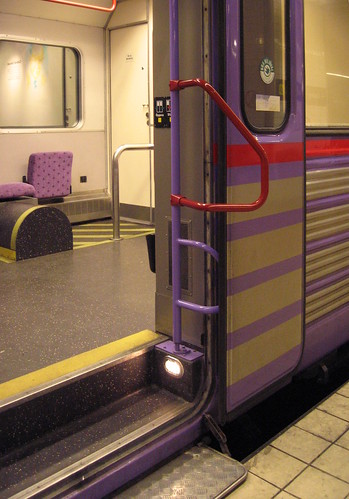
This is an example of the Swedish X11 suburban train. It has swing-plug doors with handles which rotate out over the gap between platform and train, and a drop-down step which covers the gap. These are desirable features for all new trains, not just for safety, but because they promote faster boarding and alighting, thereby reducing station dwell times. Although there is a big variation in station platform heights, getting on and off trains in Sweden is usually quite easy especially with newer stock.
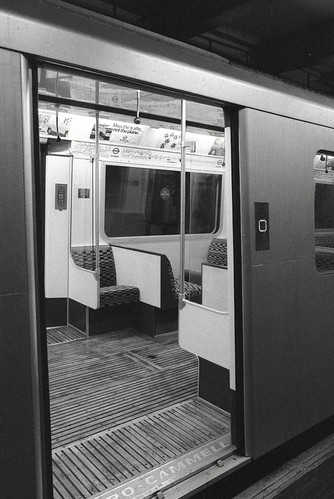
Above we see the doorway of London Underground's District Line D78 stock. These have never been considered successful. These have four single-leaf doorways instead of the traditional two-doubles and two singles at each end. It was thought that the provision of good stand-back space on either side of the doors would have sufficed to promote a good flow of people at stations but in practice these proved inadequate. A similar single-leaf door configuration was adopted for the 1983 Jubilee Line stock and was even less satisfactory on tube services, so much so that the stock was withdrawn after only 15 years in service. However, this configuration might well have been more effective than the two pairs of bi-parting doors which has been standard for most suburban stock in the UK since the mid-1970s.
These particular trains can present difficulties for people with impaired mobility due to the absence of handrails on either side of the door, which is potentially hazardous at stations with curved platforms where there is a wide gap, and where there is a large difference between platform and floor height - this can be up to 40 cm.

Another type of train which has a bad reputation for excessive station dwell times is the class 158, above, with end doors about 800 mm wide. This led to the adoption of the 1:3/2:3 double-doors configuration of their successors, the Turbostar and Electrostar family of designs. This could, however, have been a mistake. There are two features of the class 158 doorway which would impede movement on and off the train. The first is the awkward step (below), less than 150 mm from nose to riser. The second is the presence of pinch points immediately inside the entrance vestibules. With a better-designed step, possibly associated with the use of simple sliding doors, and good internal circulation space, this end-door configuration might not be significantly worse that the 1:3/2:3 layout, with advantages which will be discussed later.

An awkward step is also a feature of other trains fitted with plug doors such as the Electostar, below. At first sight this is needed to provide a closing lip for the door but such a feature is not found on trains such as the Voyager and Meridian classes, where the step board is entirely inside the vehicle. There is no obvious reason for the pronounced lower bodyside curvature, especially since the stepboard then forms a projection. This curvature also reduces width at floor level, a problem compounded when a skirting level duct is provided. According to information provided by a then Railtrack gauging engineer, there is no reason why trains cannot have straight-down sides below the windows down to 1225 above rail level. But in any case the need for a closing lip does not explain the need for the change of level in the doorways of the class 376 Electrostars with conventional pocketed sliding doors.
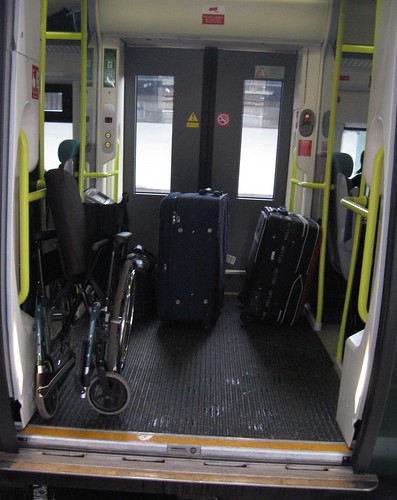

The 1:3/2:3 door configuration has now become ubiquitous. As can be seen, it leads to bunching on station platforms, though less so than with vehicles with end-door configuration. Earlier designs such as class 455 had doorways giving just 1.2 metres clear opening. Electrostars have wider doorways but standback space is minimal and the full width of the doorway opening is rarely used or even available for use, especially at busy periods, due to standing passengers getting in the way. Consequently passengers tend to board and alight in single file. In so far as these trains can be loaded and unloaded faster than end door stock such as class 158, the difference may be due as much to the better circulation space inside the vehicles than the position of the doors as such. But there is no opportunity for genuine like-for-like comparison. Despite the poor experience with the London Underground D78 stock, it may be that three or four narrower doors per vehicle give better performance than two wider ones. This is an area where research needs to be done.
Conclusion
The entrance arrangements on trains need to be the subject of further research. The location of the doors is not optimal, nor is the detail design of the doorways themselves, especially in regard to the step detail and handrail position. There is a need to move towards a specification that provides the facilities illustrated in the Swedish train at the top of this article.
Thoughts on train design - 1
Earliest days
With new trains on order and a widespread re-allocation of rolling stock, it is an opportune time to ponder rolling stock design.

From the earliest days of railways, British trains were based on the design of the stage coach. From this was evolved the Victorian compartment coach, with bench seats running across the width of the vehicle and a hinged door to each compartment on each side. First came four-wheelers, with a wheelbase of 15 feet and a length of not more than 27 feet, having up to five third-class compartments; these were the characteristic vehicle on, for instance, on London suburban railways such as the Metropolitan District Railway (above) and the North London Railway. They were also the standard for long distance trains until well into the 1890s.
In the later nineteenth century the standard length of British passenger coaches was progressively increased. First, came six-wheelers about 30 feet long, and then, from the 1870s, came bogie vehicles , initially 45 feet long, then 48 feet and 54 feet long. In the twentieth century the trend to longer vehicles continued. During the time of the Big Four private companies, the favoured length was about 60 feet, whilst the British Railways mark 1 stock was built to 57 and 64 foot 6 inch lengths, the former for sharply curved routes. Until recently the latter dimension remained an important standard as it formed the basis for the C1 loading gauge, with a vehicle length of 19.330 metres and bogies at14.174 centres; the same dimensions, rounded, were adopted for recent 20 metres (nominal) stock such as Electostars and the Siemens class 450 Desiro.
After 1970 it was realised that 23 metre vehicles, with bogies at 16 metre centres, could run over much of the system, and this dimension was adopted for such stock as mark 3, and later, DMU classes 155, 156, 159 and Turbostars. Longer vehicles were also introduced with successive builds on London Underground. But the added width was obtained at the cost of width. Whereas the C1 loading gauge for 20 metre vehicles permits a overall external width of 2.82 metres, mark 3 stock is only 2.74 metres wide, class 158/159 stock is 2.7 metres wide and the Siemens class 444 Desiros are 2.6 metreswide. These longer vehicles are also problematic on some routes, as they are running on infrastructure designed for the short Victorian four-wheelers; some station platforms are built on curves which are too sharp for the longer modern vehicles and the difficulties this causes will be discussed below.
In the later days of slam door stock, the practice was to have one door each side per compartment or seating bay on suburban stock and three doors per side on long distance stock.

Above is a suburban train of this type, dating from the 1930s. This style of coach, with 108 seats in nine compartments within a vehicle 57 feet long, optimised the seating capacity and minimised station dwell time. They remained popular with operators and passengers and the design was perpetuated when new electric multiple unit trains were procured in large numbers in the 1950s and 1960s. But they were the last of their kind. Accidents with the outward-opening doors were quite common and the separate compartments came to be perceived as unsafe. The compartment problem was solved by creating a gangway down the length of the vehicles, slightly reducing the seating capacity, but the danger of hinged doors not under the control of railway staff was never solved.
Parallel to this tradition originating in the stage coach was another, derived from the wagon, with a long saloon and doors at each end, reached, in the earliest examples, from an open balcony, which later evolved into the enclosed end-vestibule. This came from North America and was brought to Europe in the shape of the Pullman car. From a structural point of view this was a superior design as the passenger saloon could be built as a strong square-section tubular enclosure.

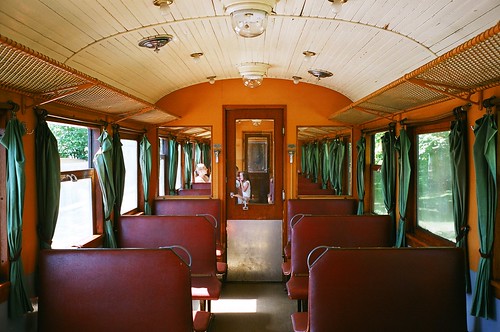
This style of vehicle was the prototype for new trains built for the London Underground when it was electrified in the early 1900s, as well as for the tube which started to be built around the same time. But soon it was discovered that the end doors were insufficient, and intermediate doors were provided so as to speed up loading and unloading at busy stations. Over the years, this evolved into the modern type of London Underground train with two pairs of wide double doors and single doors at each end of the vehicle.
British long distance stock eventually came to be built to the end-door design as it lent itself perfectly to monocoque construction, with, depending on the design philosophy, a protective or sacrificial end-zone for crash protection. A good example of this practice is the mark 3, seen below, in the electric multiple unit version, the class 442 built for the Bournemouth line, with power-operated doors at the extreme outer ends.
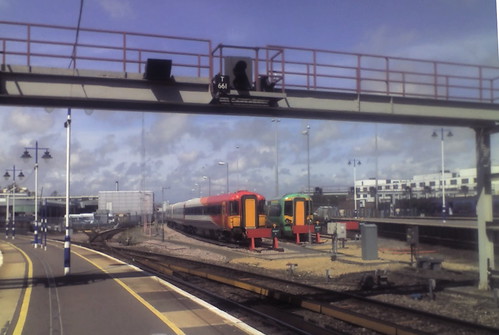
But now, the limitations of the Victorian infrastructure become apparent. The trains have been transferred to the Brighton line and are running on Brighton and Gatwick Express services. It turns out that they are awkward to get on at convex curved platforms, owing to the large gap. Southern was not keen on taking these trains into its fleet because of amongst other reasons, the station dwell time for this type of stock is reputed to be excessive, but was apparently unaware of the problem of the gap at convex platforms.
A similar problem occurs with the 23 metre long Turbostar trains (below), with doors about four metres from each end, the so-called 1/3:2/3 layout, but in this case, the gap occurs on concave platforms as the vehicles cut off a chord.

But not all 23 metre vehicles are troublesome in this way. The class 158 stock (below) has doorways over the bogie centres, which minimises the gap between platform and train in all circumstances. But these trains are notorious for their station dwell times and this is why the design of the later Turbostar, and most electric multiple units has been based on the Networker suburban configuration with 1/3:2/3 door configuration.
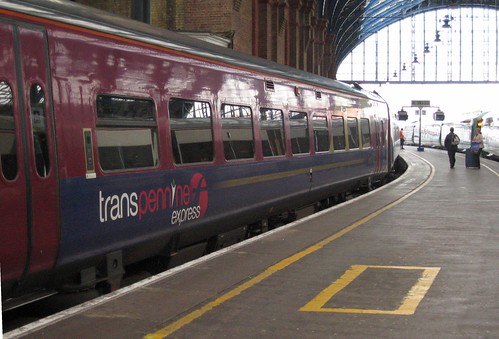
The demise of the compartment coach

The final examples of the traditional compartment coach were like these above, built in very large numbers by British Railways from the mid-1950s. These were formed into electric multiple unit trains and used on suburban services. They would remain in service until the end of the twentieth century. In the late 1960s it was decided to adopt trains with power-operated sliding doors similar to those used on London Underground. Prototypes were built, with three pairs of sliding doors per side trains, but the production series had only two pairs of doors per side, and from then on the now familiar 1:3/2:3 door configuration became standard on the national railway system - although the LMS company had built a fleet to this layout for Liverpool suburban routes in 1939 and the LNER for London and Manchester suburban routes in 1946.
An example of the first of these, class 313, with aluminium panelling, built in 1975 for the electrification of the Great Northern routes out of London, is shown below.
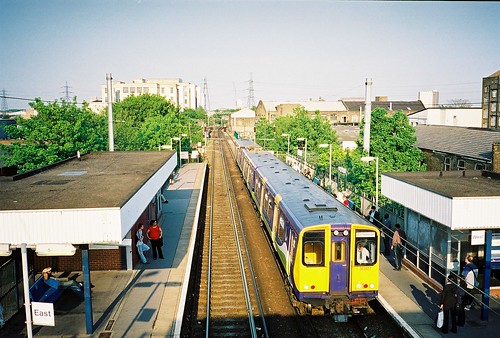
As soon as they entered service, it was apparent that they were not ideal for congested inner suburban routes. The doors were only 1.2 metres wide, and, ignoring London Underground's experience, there was no standback space to either side of the draught screens. At busy periods, therefore, passengers alighted and boarded in single file, with the result that station dwell times were extended in comparison to the slam door trains they replaced. However, the configuration was perpetuated in huge numbers. Fleets were procured for the Great Eastern, Glasgow and Liverpool suburban routes (classes 313, 314, 315), and the same basic design was adapted for mark 3 steel construction and put into service in South West London, the Cambridge route, the Glasgow suburbs, and London Midland outer suburban lines (classes 317, 319, 319, 320, 321, 322) .
By 1986, British Rail had been divided into Sectors, and one of these, London and South East, was rebranded Network South East and designs for a new fleet of trains put in hand to replace the remaining slam door stock. This eventually appeared as the Networker, in 20 metre electric multiple unit versions mostly for South-East London suburban routes and as a 23 metre diesel multiple unit for Great Western routes; the latter was constructed to the full 2.82 width, which the larger Great Western clearances made possible.
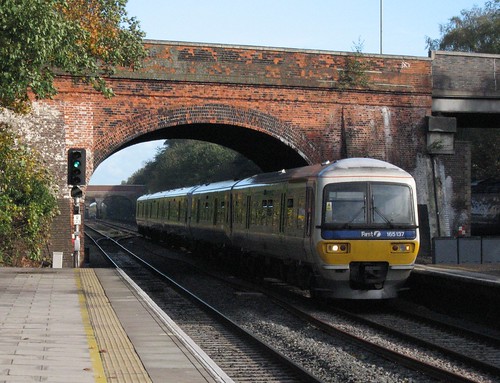
These continue the 1:3/2:3 door layout but the doors were of the plug type, sliding outside the vehicles and eliminating the need for space-consuming sliding door pockets. But design of the plug doors required a closing lip on the floor, creating a shallow step and reintroducing the narrow step-board - less than 150 mm from nose to riser - which was one of the less satisfactory features of slam door stock.
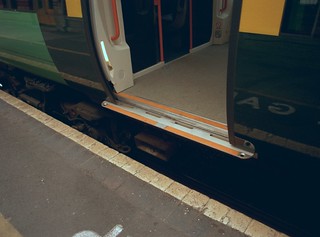
This has become a feature of all suburban stock with plug doors - including the Bombardier Electrostars, and Turbostars, and the Siemens Desiros. In some circumstances, it can present a hazard, especially at low concave platforms such as this one at Lewes. The difficulty of boarding and alighting is compounded by the position of the door handles, which is a bit too far inside the train to reach comfortably. The plug doors proved troublesome initially, due to their complexity, and the safety devices caused delays as it they could not be opened until 15 seconds after the train had stopped, with further delays before the train could start again after they were closed. This led to the abandonment of the plug door in favour of the older type of pocketed sliding door. These are a feature of later Electrostars of class 376, as used in South-East London services where they replaced Networkers after less than 15 years in service.

But one of the desirable features of slam door stock has never been replaced at least not in the UK - the door provided support over the gap between the platform and the train, and nearly all passengers held on to it when getting on and off.
Length and width
There is a relation between the length and width of a railway vehicle. In the earliest part of the twentieth century a maximum external width of 2.82 metres became standard. This was incorporated into the C1 loading gauge, and applied to vehicles of a nominal 20 metres length (63 feet 6 inches) and having bogies at 14.174 metre centres. In the late 1960s it was realised that a 23 metre long vehicle, with bogies at 16 metre centres, was possible. These emerged as mark 3 stock, having a width of 2.74 metres, and limited to routes cleared for a new C3 restriction. Mark 3 stock has the same internal width as mark 1 stock due to the use of recessed door handles, and ends are slightly tapered. Bogies are 3.5 metres from the ends of the vehicles, giving rise to considerable relative movement between vehicles on curves, and consequent wear and tear on gangway connection.
The maximum width of vehicles is determined by a formula which can be used to determine the extent of overthrow and kick-out on curved track. The most important term in the equation is that relating to the distance between the bogies. The width must be reduced from the maximum permitted by an amount proportional to the square of the distance between the bogies. Calculations based on 160 metre radius curvature show that a vehicle about 21.2 metres long with bogies about 15.2 metres apart need be little narrower (2 cm) than the maximum permitted, still currently 2.82 metres. This will provide nine bays of 1.90 metres, plus space for vestibules and standard toilets.
Conclusion
The situation remains unsatisfactory. A 23 metre vehicle is sub-optimal from the point of view of width and consequent comfort, whilst none of the stock from the class 313 of 1975 until the later class 376 Electrostars has performed as intended. There is a shortage of seating capacity and station dwell times are excessive, due to the lack of circulation space inside the doorways. It is likely that the awkward step associated with the use of plug doors also prolongs station dwell times as people have to tread carefully.
In an attempt to deal with the problem of station dwell times, most of the suburban sliding-door stock from this period has been rebuilt to give additional circulation space, or redeployed to longer distance routes. Of course, circulation space can only be provided at the expense of seats.
The latest Electrostars for London Overground take this principle to an extreme, being fitted with sliding doors and longitudinal seats only. So long as they are used only for short trips, this is probably an acceptable solution, and apart from their weight, is the most appropriate use and configuration of this type of stock.
With new trains on order and a widespread re-allocation of rolling stock, it is an opportune time to ponder rolling stock design.

From the earliest days of railways, British trains were based on the design of the stage coach. From this was evolved the Victorian compartment coach, with bench seats running across the width of the vehicle and a hinged door to each compartment on each side. First came four-wheelers, with a wheelbase of 15 feet and a length of not more than 27 feet, having up to five third-class compartments; these were the characteristic vehicle on, for instance, on London suburban railways such as the Metropolitan District Railway (above) and the North London Railway. They were also the standard for long distance trains until well into the 1890s.
In the later nineteenth century the standard length of British passenger coaches was progressively increased. First, came six-wheelers about 30 feet long, and then, from the 1870s, came bogie vehicles , initially 45 feet long, then 48 feet and 54 feet long. In the twentieth century the trend to longer vehicles continued. During the time of the Big Four private companies, the favoured length was about 60 feet, whilst the British Railways mark 1 stock was built to 57 and 64 foot 6 inch lengths, the former for sharply curved routes. Until recently the latter dimension remained an important standard as it formed the basis for the C1 loading gauge, with a vehicle length of 19.330 metres and bogies at14.174 centres; the same dimensions, rounded, were adopted for recent 20 metres (nominal) stock such as Electostars and the Siemens class 450 Desiro.
After 1970 it was realised that 23 metre vehicles, with bogies at 16 metre centres, could run over much of the system, and this dimension was adopted for such stock as mark 3, and later, DMU classes 155, 156, 159 and Turbostars. Longer vehicles were also introduced with successive builds on London Underground. But the added width was obtained at the cost of width. Whereas the C1 loading gauge for 20 metre vehicles permits a overall external width of 2.82 metres, mark 3 stock is only 2.74 metres wide, class 158/159 stock is 2.7 metres wide and the Siemens class 444 Desiros are 2.6 metreswide. These longer vehicles are also problematic on some routes, as they are running on infrastructure designed for the short Victorian four-wheelers; some station platforms are built on curves which are too sharp for the longer modern vehicles and the difficulties this causes will be discussed below.
In the later days of slam door stock, the practice was to have one door each side per compartment or seating bay on suburban stock and three doors per side on long distance stock.

Above is a suburban train of this type, dating from the 1930s. This style of coach, with 108 seats in nine compartments within a vehicle 57 feet long, optimised the seating capacity and minimised station dwell time. They remained popular with operators and passengers and the design was perpetuated when new electric multiple unit trains were procured in large numbers in the 1950s and 1960s. But they were the last of their kind. Accidents with the outward-opening doors were quite common and the separate compartments came to be perceived as unsafe. The compartment problem was solved by creating a gangway down the length of the vehicles, slightly reducing the seating capacity, but the danger of hinged doors not under the control of railway staff was never solved.
Parallel to this tradition originating in the stage coach was another, derived from the wagon, with a long saloon and doors at each end, reached, in the earliest examples, from an open balcony, which later evolved into the enclosed end-vestibule. This came from North America and was brought to Europe in the shape of the Pullman car. From a structural point of view this was a superior design as the passenger saloon could be built as a strong square-section tubular enclosure.


This style of vehicle was the prototype for new trains built for the London Underground when it was electrified in the early 1900s, as well as for the tube which started to be built around the same time. But soon it was discovered that the end doors were insufficient, and intermediate doors were provided so as to speed up loading and unloading at busy stations. Over the years, this evolved into the modern type of London Underground train with two pairs of wide double doors and single doors at each end of the vehicle.
British long distance stock eventually came to be built to the end-door design as it lent itself perfectly to monocoque construction, with, depending on the design philosophy, a protective or sacrificial end-zone for crash protection. A good example of this practice is the mark 3, seen below, in the electric multiple unit version, the class 442 built for the Bournemouth line, with power-operated doors at the extreme outer ends.

But now, the limitations of the Victorian infrastructure become apparent. The trains have been transferred to the Brighton line and are running on Brighton and Gatwick Express services. It turns out that they are awkward to get on at convex curved platforms, owing to the large gap. Southern was not keen on taking these trains into its fleet because of amongst other reasons, the station dwell time for this type of stock is reputed to be excessive, but was apparently unaware of the problem of the gap at convex platforms.
A similar problem occurs with the 23 metre long Turbostar trains (below), with doors about four metres from each end, the so-called 1/3:2/3 layout, but in this case, the gap occurs on concave platforms as the vehicles cut off a chord.

But not all 23 metre vehicles are troublesome in this way. The class 158 stock (below) has doorways over the bogie centres, which minimises the gap between platform and train in all circumstances. But these trains are notorious for their station dwell times and this is why the design of the later Turbostar, and most electric multiple units has been based on the Networker suburban configuration with 1/3:2/3 door configuration.

The demise of the compartment coach

The final examples of the traditional compartment coach were like these above, built in very large numbers by British Railways from the mid-1950s. These were formed into electric multiple unit trains and used on suburban services. They would remain in service until the end of the twentieth century. In the late 1960s it was decided to adopt trains with power-operated sliding doors similar to those used on London Underground. Prototypes were built, with three pairs of sliding doors per side trains, but the production series had only two pairs of doors per side, and from then on the now familiar 1:3/2:3 door configuration became standard on the national railway system - although the LMS company had built a fleet to this layout for Liverpool suburban routes in 1939 and the LNER for London and Manchester suburban routes in 1946.
An example of the first of these, class 313, with aluminium panelling, built in 1975 for the electrification of the Great Northern routes out of London, is shown below.

As soon as they entered service, it was apparent that they were not ideal for congested inner suburban routes. The doors were only 1.2 metres wide, and, ignoring London Underground's experience, there was no standback space to either side of the draught screens. At busy periods, therefore, passengers alighted and boarded in single file, with the result that station dwell times were extended in comparison to the slam door trains they replaced. However, the configuration was perpetuated in huge numbers. Fleets were procured for the Great Eastern, Glasgow and Liverpool suburban routes (classes 313, 314, 315), and the same basic design was adapted for mark 3 steel construction and put into service in South West London, the Cambridge route, the Glasgow suburbs, and London Midland outer suburban lines (classes 317, 319, 319, 320, 321, 322) .
By 1986, British Rail had been divided into Sectors, and one of these, London and South East, was rebranded Network South East and designs for a new fleet of trains put in hand to replace the remaining slam door stock. This eventually appeared as the Networker, in 20 metre electric multiple unit versions mostly for South-East London suburban routes and as a 23 metre diesel multiple unit for Great Western routes; the latter was constructed to the full 2.82 width, which the larger Great Western clearances made possible.

These continue the 1:3/2:3 door layout but the doors were of the plug type, sliding outside the vehicles and eliminating the need for space-consuming sliding door pockets. But design of the plug doors required a closing lip on the floor, creating a shallow step and reintroducing the narrow step-board - less than 150 mm from nose to riser - which was one of the less satisfactory features of slam door stock.

This has become a feature of all suburban stock with plug doors - including the Bombardier Electrostars, and Turbostars, and the Siemens Desiros. In some circumstances, it can present a hazard, especially at low concave platforms such as this one at Lewes. The difficulty of boarding and alighting is compounded by the position of the door handles, which is a bit too far inside the train to reach comfortably. The plug doors proved troublesome initially, due to their complexity, and the safety devices caused delays as it they could not be opened until 15 seconds after the train had stopped, with further delays before the train could start again after they were closed. This led to the abandonment of the plug door in favour of the older type of pocketed sliding door. These are a feature of later Electrostars of class 376, as used in South-East London services where they replaced Networkers after less than 15 years in service.

But one of the desirable features of slam door stock has never been replaced at least not in the UK - the door provided support over the gap between the platform and the train, and nearly all passengers held on to it when getting on and off.
Length and width
There is a relation between the length and width of a railway vehicle. In the earliest part of the twentieth century a maximum external width of 2.82 metres became standard. This was incorporated into the C1 loading gauge, and applied to vehicles of a nominal 20 metres length (63 feet 6 inches) and having bogies at 14.174 metre centres. In the late 1960s it was realised that a 23 metre long vehicle, with bogies at 16 metre centres, was possible. These emerged as mark 3 stock, having a width of 2.74 metres, and limited to routes cleared for a new C3 restriction. Mark 3 stock has the same internal width as mark 1 stock due to the use of recessed door handles, and ends are slightly tapered. Bogies are 3.5 metres from the ends of the vehicles, giving rise to considerable relative movement between vehicles on curves, and consequent wear and tear on gangway connection.
The maximum width of vehicles is determined by a formula which can be used to determine the extent of overthrow and kick-out on curved track. The most important term in the equation is that relating to the distance between the bogies. The width must be reduced from the maximum permitted by an amount proportional to the square of the distance between the bogies. Calculations based on 160 metre radius curvature show that a vehicle about 21.2 metres long with bogies about 15.2 metres apart need be little narrower (2 cm) than the maximum permitted, still currently 2.82 metres. This will provide nine bays of 1.90 metres, plus space for vestibules and standard toilets.
Conclusion
The situation remains unsatisfactory. A 23 metre vehicle is sub-optimal from the point of view of width and consequent comfort, whilst none of the stock from the class 313 of 1975 until the later class 376 Electrostars has performed as intended. There is a shortage of seating capacity and station dwell times are excessive, due to the lack of circulation space inside the doorways. It is likely that the awkward step associated with the use of plug doors also prolongs station dwell times as people have to tread carefully.
In an attempt to deal with the problem of station dwell times, most of the suburban sliding-door stock from this period has been rebuilt to give additional circulation space, or redeployed to longer distance routes. Of course, circulation space can only be provided at the expense of seats.
The latest Electrostars for London Overground take this principle to an extreme, being fitted with sliding doors and longitudinal seats only. So long as they are used only for short trips, this is probably an acceptable solution, and apart from their weight, is the most appropriate use and configuration of this type of stock.
Prenumerera på:
Inlägg (Atom)
Ultimate net zero lunacy?
The ultimate net zero lunacy is probably de-carbonising and trying to electrify the entire railway system. In the first place, the railways...
-
I wrote to my MP on two entirely separate issues recently. The first was to do with the replacement for the Inter City 125 train, which at £...
-
The ultimate net zero lunacy is probably de-carbonising and trying to electrify the entire railway system. In the first place, the railways...
-
The FT has run a couple of pieces on Sweden this week. The first was a report of the outbreak of car burning, the second, today, on the rise...